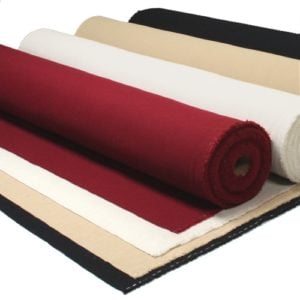Acoustic Fabric
Showing the single result
-

Nankarrow GeoWeave™ ‘Breathe Fire Rated Acoustic Fabric for Walls, Ceilings, & Panels
₹330.00 – ₹520.00 incl GST Running Metre (R. Mtr) Select options
Our range of acoustic fabric and acoustic cloth that can be used to wrap your acoustic panels or for wall-to-wall cladding, using our gripper system.
- Acoustical fabric for wrapping acoustical wall panels, such as our Nankarrow fabrics, are designed to let sound energy into an acoustical panel to do its job, rather than reflecting sound off the surface.
- All acoustic fabrics are made of recycled polyester and are Class A fire rated, and is designed to absorb mid to high frequency sound, in order to reduce ambient noise and chatter in office areas. Usually a +3dB boost for high frequencies can be applied on room speakers to compensate for brightness loss.
Acoustic Fabrics play an important functional and aesthetic role on an interior environment. The Nankarrow fabric line offers a wide array of designs with variations of contents, weight, repeat, breaking strength, tear resistance, NRC rating and directional vs. non-directional. Click on the product name for further information and pricing.
Below is a description of common terms you will need to know when choosing an acoustic fabric:
- Repeat– The length between the starting point and ending point of a pattern.
- Breaking Strength– The minimum tensile strength needed to tear the fabric apart.
- Tear Resistance– The capacity of a fabric to withstand the tearing force required to propogate a tear after its initiation.
- NRC rating– How much sound the fabric reflects into the absorptive material backing it. The NRC rating of a fabric is determined by placing an anechoic termination behind the fabric and measuring how much sound can penetrate the fabric and reach the anechoic termination.
Acoustically transparent fabric refers to a type of fabric that allows sound to pass through it while maintaining its physical integrity. It is commonly used in applications where speakers or audio equipment are placed behind the fabric, such as home theaters, cinemas, conference rooms, or concert venues. The advantages of acoustically transparent fabric include:
- Sound Transparency: The primary advantage of acoustically transparent fabric is its ability to allow sound to pass through it without significant loss or distortion. It ensures that audio quality remains clear and unobstructed, enabling speakers to produce accurate and natural sound reproduction.
- Hidden Speakers: Acoustically transparent fabric enables a clean and aesthetically pleasing setup by allowing speakers to be placed behind the fabric, hidden from view. This setup is particularly useful in home theaters or media rooms, where speakers can be seamlessly integrated into the room decor without compromising sound quality.
- Improved Immersion: When speakers are placed behind acoustically transparent fabric, the sound appears to come from the screen or specific locations, creating a more immersive experience. This effect enhances the viewing or listening experience, making it more engaging and realistic.
- Design Flexibility: Acoustically transparent fabric comes in various colors, patterns, and finishes, allowing it to blend seamlessly with the room’s interior design. It provides flexibility in achieving the desired aesthetic without sacrificing sound quality.
- Acoustic Treatment: In addition to sound transparency, acoustically transparent fabric can contribute to acoustic treatment within a room. By covering wall panels or other sound-absorbing materials with acoustically transparent fabric, you can maintain the sound absorption properties while creating an appealing visual surface.
- Versatility: Acoustically transparent fabric can be used in different applications beyond home theaters or cinemas. It finds utility in professional audio environments, stage productions, conference rooms, and concert halls, where sound quality and visual appeal are crucial.
Overall, acoustically transparent fabric offers a combination of sound transparency, design flexibility, and protection for speakers, making it an ideal choice for applications where both audio performance and aesthetics are important.
